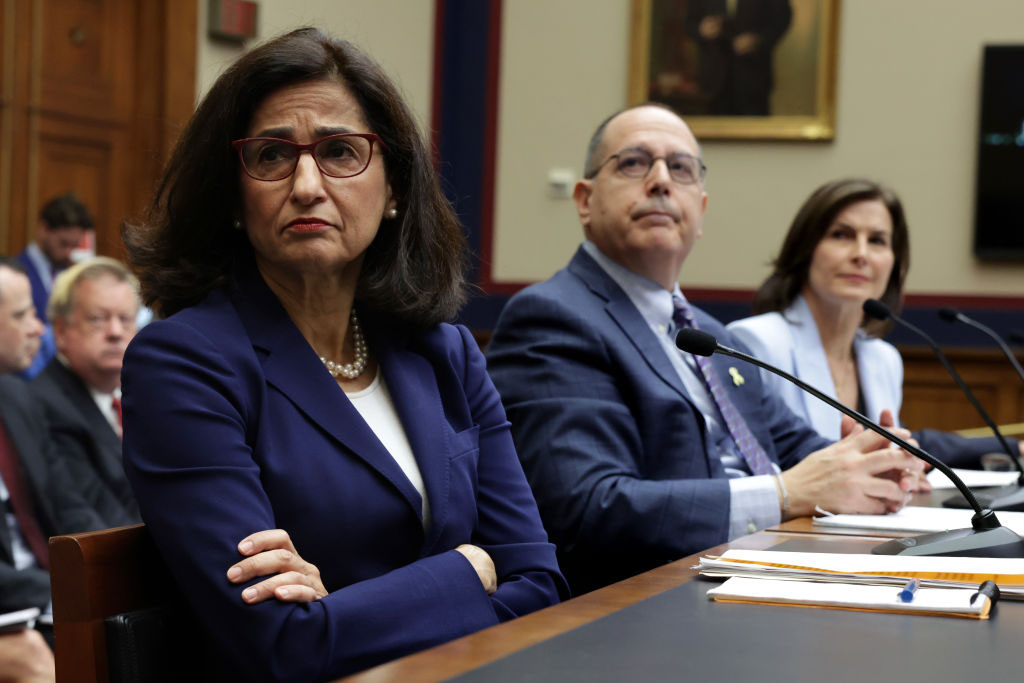What is there about klezmer music that sends feet flying and excitement levels of certain Jewish audiences soaring? Nostalgia for the past or a just-found fondness for a “new” music”? Whatever it is, when the klezmer band struck up a “Freylach,” almost instantly, a woman in a red baseball cap jumped to her feet, raised her arms to the sky and began bouncing joyfully to the music. She was quickly joined by someone in a jaunty straw hat and a T-shirt emblazoned with the word “Danceaholic.” Soon, there was an impromptu circle of happy bouncers — young and old — stepping lively under the warm California sun.
So began “KlezFest at the Skirball,” a celebration of klezmer music and its role in Yiddish culture. The event, which took place on Sunday, April 13, in the courtyard of the Skirball Cultural Center, attracted some 250 participants, from octogenarians to 8-year-olds.
I was there with my husband and teen-age son, instruments in tow. Bernie, my husband and the trumpetmeister, has long been a mainstay of our synagogue’s official band, Close Enough for Klezmer. Jeffrey, our son, who plays classical and jazz clarinet, is also a Klezmer wannabe. Over the last decade, this home-grown band has brought its members both inspiration and aggravation, but, musically, it has grown a bit stale. So six band cronies (and their offspring) showed up at KlezFest, looking for new ideas.
Other folks had other agendas. Nancy Carroll, who’s taking a Yiddish-literature class at Los Angeles Valley College, signed on for KlezFest because this “is a perfect illustration of what we’re studying.”
Joyce Hart, raised in a Yiddish-speaking household in Canada, is so passionate about the mamaloshen that she used to make weekly treks to Fairfax just to listen to people speak. KlezFest enabled her to sing in Yiddish, hear talks on Yiddish folklore, and applaud Yiddish-theater songs belted out in the style of Second Avenue.
A young man named Richard, who’s getting married in September, came to KlezFest in search of hints on how to integrate his Eastern European Jewish heritage into an American Jewish wedding. The fact that the day was to climax in a mock wedding ceremony made KlezFest, for Richard, the place to be.
One especially distinctive presence was that of Joy Krauthammer, dressed in flowing purple and chains of silver amulets. She proudly displayed the large African buffalo-skin drum she’d adorned with ribbons and snapshots of past mentors, including “my number one teacher in the world, Rabbi Shlomo Carlebach.” In attending the KlezFest-sponsored concert at the Wadsworth Theatre, Krauthammer had found an excitement that bordered on the spiritual: “I was doing Shabbos at the concert.” Now she was primed to learn how to bring her African and Middle Eastern percussion skills into the Klezmer idiom.
While the Yiddish-culture enthusiasts enjoyed lectures and a dance workshop, the 50 aspiring klezmorim present were sent off for in-depth master classes with members of The Klezmatics and Klazzj. These professionals gave solid and specific advice. Violinists were told to forgo vibrato, and got tips on how to incorporate that distinctive klezmer “sob” into their sound. Brass players were initiated into the mysteries of the Freygish Scale. There was a special section for accordionists and (high on the hill above the Skirball) one for wailing klezmer clarinets. Guitarists joined forces with a classical mandolin player and the owner of a Turkish oud to learn about plucking and strumming, klezmer-style.
After lunch, the instrumentalists were melded into ensembles for some ad hoc music-making. Close Enough for Klezmer found itself in a basement room, where a maven from The Klezmatics gave pointers on how to rearrange an old tune from the repertoire for maximum impact.
Nor was energy in short supply in the courtyard, where the promised wedding procession was about to start. The KlezFest organizers had supplied 12-foot puppets representing a giant-sized khosn (groom) and kalle (bride). There was also a billowing chuppah, made by the children in a crafts workshop while their elders strummed and fiddled. A long-bearded shtetl rabbi dramatically read off the items the groom had promised his chosen one — 200 silver zuzim, feather pillows, a brass bed and a Stairmaster. After the groom, his huge fingers fluttering anxiously, lifted the veil from his shy bride’s punim, KlezFest participants of all ages joined the celebration by waving multicolored banners and dancing along to the strains of the very haimish Ellis Island Band.
At last, happily sated with Yiddishkayt, the participants drifted out to the parking lots and back to their Southern California lives.
As for Close Enough for Klezmer, its members were blissfully close to overload. So much music, so little time.
Beverly Gray writes about education for The Jewish
Journal from Santa Monica.
All rights reserved by author.






















 More news and opinions than at a Shabbat dinner, right in your inbox.
More news and opinions than at a Shabbat dinner, right in your inbox.